Australopithecus sediba
Online Biology Dictionary
|
|
EUGENE M. MCCARTHY, PHD
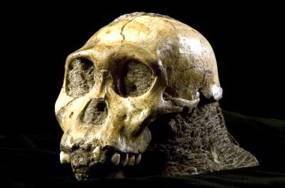
|
|
Australopithecus sediba — The U.W. 88-50 (MH1) cranium, juvenile male. Photo: Brett Eloff courtesy of Lee Berger, Univ. of Witwatersrand (click to enlarge) |
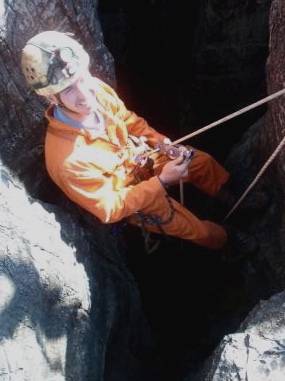
|
| Rappelling into the cave |
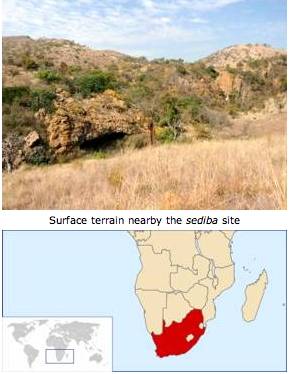
|
|
Location of South Africa Credit: Vardion |
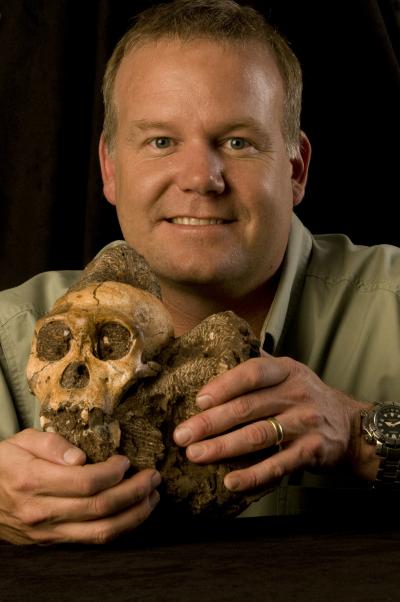
|
| Lee Berger, of the University of the Witwatersrand, Johannesburg, holding the MH-1 cranium. Image: University of the Witwatersrand |
Australopithecus sediba is the name assigned a newly described hominid based on two recently discovered partial skeletons, one that of a juvenile male, the other, that of an adult female. The remains, from Malapa cave, a fossil site about 50 kilometers northwest of Johannesburg, South Africa, are of Pleistocene age, dating to 1.98 mya. The find was made August 15, 2008, but first announced to the public on April 8, 2010 in the journal Science. Malapa is in the Cradle of Humankind World Heritage Site.
The discoverer was a nine-year-old boy, Matthew Berger, who was surprised to see human-like teeth protruding from the floor of the cave. He hurried to tell his dad, South African paleoanthropologist Lee Berger, who, with the help of colleagues, soon brought the remains of a pair of hominids to light. The two skeletons lay close together in a part of the cave inaccessible to scavengers, so they are quite well-preserved. Conceivably, they are the remains of a mother and child.
"The fossils occur together in a near-articulated state in the sedimentary remains of a deeply eroded cave system," says Paul Dirks one of the researchers, "They were laid down by a single debris flow, indicating the timing of their deaths were closely related and occurred shortly before the debris flow carried them to their place of burial."
The researchers suggest the cave could have acted as a death trap for animals seeking water. They have identified the fossils of a variety of creatures in the cave, including saber-toothed cats, a wildcat, a brown hyena, a wild dog, antelopes, and a horse.
"One possible explanation for their entry into the cave could have been that they needed water," said Dirks. "To explain the fossil assemblage and their well-preserved state, we would speculate that perhaps at the time of their death, the area in which sediba lived experienced a severe drought.…Animals may have smelled the water, ventured in too deep, fallen down hidden shafts in the pitch dark, or got lost and died."
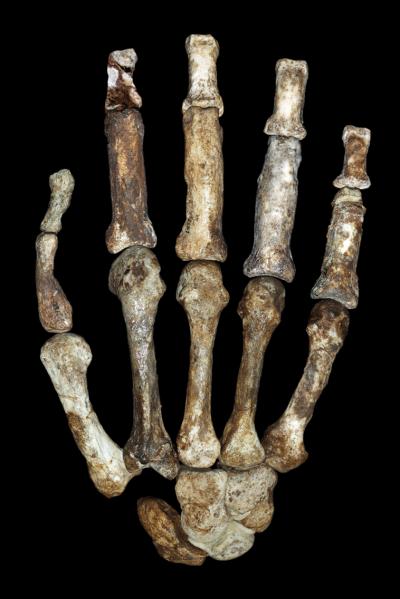
|
| The right hand of A. sediba. Image: Peter Schmid |
Information from the skeletons shows Australopithecus sediba was bipedal, with a height of about 1.27 meters (4'2"), and that it shared certain physical traits of early Homo. In particular, it had a somewhat prominent nose and strong hands that could have made and used stone tools (there is as yet no evidence that this hominid used fire). Its brain size was still small (its cranial capacity is estimated at 420–450 cc), but it had long legs and, the researchers say, a pelvis that would have given it more "modern" locomotion similar to that of Homo erectus and modern humans (Homo sapiens). So Berger and his coauthors believe these remains probably belonged to a direct ancestor of Homo, or a close relative thereof.
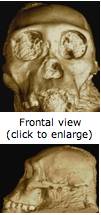
|
|
Lateral view (Enlarged image) |
"It is not possible to establish the precise phylogenetic position of Australopithecus sediba in relation to various species assigned to early Homo," writes Berger, a lead author of one of the Science reports. "We can conclude that…this new species shares more derived features with early Homo than any other known australopith species, and thus represents a candidate ancestor for the genus, or a sister group to a close ancestor that persisted for some time after the first appearance of Homo."
Thus far, excavations at the site have been preliminary. However, in the time since the Science paper was published, more remains have been discovered.
"The discovery of so many partial skeletons from a single site is unprecedented," says Andy Herries another of the coauthors, "It enables us to understand the full skeletal anatomy of these early human ancestors rather than relying on fragments of a skull or some teeth, which can sometimes be misleading."
More extensive excavations are scheduled. No doubt they will reveal even more fossils and additional information about the climate and environment in which Australopithecus sediba lived.
|
Pronunciation: AW-strail-ō-PITH-ə-kəs sə-DEEB-ə Habitat: Grassy plains transected by wooded valleys. Etymology: The word sediba means "fountain" or "wellspring" in Sotho, a Bantu language spoken primarily in South Africa. Australopithecus is constructed from the Latin prefix australo- and the Greek suffix -pithecus. |
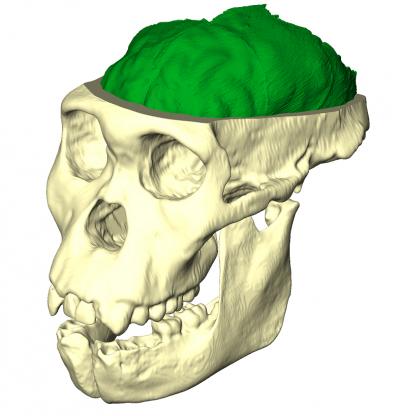 A. sediba (MH-1) cranium: Computer-generated reconstruction with endocast (shown in green) partially visible. Credit: Dr Kristian Carlson, courtesy of the University of the Witwatersrand
A. sediba (MH-1) cranium: Computer-generated reconstruction with endocast (shown in green) partially visible. Credit: Dr Kristian Carlson, courtesy of the University of the Witwatersrand
|
References:
Berger, L. R., de Ruiter, D. J., Churchill, S. E., Schmid, P., Carlson, K. J., Dirks, P. H. G. M., Kibii, J. M. 2010. Australopithecus sediba: A New Species of Homo-Like Australopith from South Africa, Science 328 (5975): 195–204, doi:10.1126/science.1184944.
Dirks, P. H. G. M., Kibii, J. M., Kuhn, B. F., Steininger, C., Churchill, S. E., Kramers, J. D., Pickering, R., Farber, D. L. et al. 2010. Geological Setting and age of Australopithecus sediba from Southern Africa, Science 328 (5975): 205–208, doi:10.1126/science.1184950.
Most shared on Macroevolution.net:
Human Origins: Are we hybrids?
On the Origins of New Forms of Life
Mammalian Hybrids
Cat-rabbit Hybrids: Fact or fiction?
Famous Biologists
Dog-cow Hybrids
Georges Cuvier: A Biography
Prothero: A Rebuttal
Branches of Biology
Dog-fox Hybrids